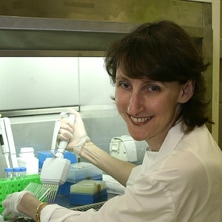Ancient enzyme resurrected for commercial biocatalysis
26 Oct 2018 Belle Dumé
By “resurrecting” the genetic sequence of an ancestral form of the technologically important P450 enzymes, researchers at the University of Queensland in Brisbane, Australia, have succeeded in significantly improving its thermal stability. The enzyme can now be made to be robust to temperatures as high as 66°C and better resist solvents compared to the non-stabilised form. The new technique might be applied to a whole range of other enzymes and proteins and could revolutionize commercial biocatalysis. The stabilised enzymes will also be ideal for studying the fundamental function and structure of proteins to better understand how they work.
Enzymes will play a crucial role as catalysts in the emerging bioeconomy of the 21st century, says Elizabeth Gillam of the School of Chemistry and Molecular Biosciences at the University of Queensland, who led this research effort. The problem is that naturally occurring enzymes are often not very stable at the elevated temperatures and over the long time periods routinely employed in industrial processes. “It is difficult to design an enzyme so that it is thermostable because proteins are very complex and we simply don’t know enough about how they work to design them from scratch, despite much intensive and costly wet-lab research over the past decades.
“By stabilising cytochrome P450 enzymes, which are involved in the production of many naturally occurring drugs, flavours, fragrances, pesticides, hormones and other interesting chemicals by bacteria, plants and animals, we can now conceive of them being as used as ‘off the shelf’ catalysts for the first time. This will accelerate the field of biocatalysis and allow chemical processes to become more efficient and environmentally friendly.”
Ancient enzymes were more thermostable
In the past, Earth was much hotter than it is today and in pre-Cambrian times, for example, ocean temperatures were as high as 60°C or more. The enzymes in any organisms around at this time (which were mainly primitive marine microorganisms such as bacteria and archaea) would have had to tolerate these temperatures. “In more recent times, such as when the first complex animals and plants, and ultimately vertebrates like us evolved (around 450 million years ago), temperatures were thought to be much milder (within about 10 degrees of those we enjoy today). There was therefore no need for enzymes to be so thermostable.
“To ‘resurrect’ ancestral more thermally stable P450 enzymes that existed at the time the first vertebrates began to appear, we began by obtaining all the gene sequences of this enzyme that we could and worked out the similarities between their sequences and the evolutionary relationships between them all,” she tells Physics World. “We then determined the most likely sequence of their common ancestor (a best guess at the gene from which they all evolved) using a computer algorithm. We then had this synthesized, put it into a bacterium to make the corresponding protein and tested its properties.”
Making biocatalytic process less costly
The researchers looked at what reactions the ancestral P450 could catalyse and found that it was very similar to the form of the enzyme found in the human liver responsible for clearing drugs and toxic metabolites. “The key difference is that the ancestral version of this enzyme can work at high temperatures and lasts about a hundred times longer than the modern-day human enzyme (which is already used to some degree in pharmaceutical biocatalysis),” explains Gillam. “This means that it could be used for a longer period in a commercial process and so yield more product for the same amount of enzyme employed, making a biocatalytic process less costly overall.”READ MORE

And that is not all: the team also showed that its approach works with another enzyme, ketol-acid reductoisomerase or KARI, which can be used for producing biofuels. The strategy might thus be applied to a whole range of enzymes and proteins, says Gillam.
Fundamental studies on proteins will now be easier
As well as potentially revolutionizing commercial biocatalysis, the new thermally stable enzymes will now allow us to more easily study the fundamental nature of proteins, she adds. “Thermostable proteins are much easier to work with because they do not fall apart as quickly as their less-stable counterparts when purified, so we will be able to determine their structure and explore the function of a thermostable ancestor to better understand the related modern (extant) descendant.
“There is much data coming out of genome sequencing projects at the moment but we still don’t have a clue about the structure and function of the proteins many genes encode. This is known as the ‘dark proteome’. Having stable versions of these uncharacterized proteins means we can now study them more easily, work out what they look like and potentially what they do.

“Analysing the structures of these enzymes will also tell us a lot about how proteins have evolved over time. We could possibly exploit these natural evolutionary processes to work out their ‘design rules’ and repurpose proteins for our own ends.”
The researchers say they are now looking at how these thermostable P450s can be used in synthetic biology and plan to design and test novel molecular devices for different applications – such as detecting and cleaning up pollutants in wastewater, to improving the effectiveness and safety of chemotherapy drugs.
“We also want to find out what these ancestral enzymes really did in ancient organisms,” says Gillam. “Were they originally responsible for ‘chemical defence’ as their modern cousins are in humans and other animals? Or did they evolve their catalytic diversity in response to selection pressure during evolution? How were they shaped by evolution into the fascinating and powerful catalysts we have today?”
The present work is detailed in Nature Catalysis 10.1038/s41929-018-0159-5.

26/10/2018 from physicsworld.com

Δεν υπάρχουν σχόλια:
Δημοσίευση σχολίου